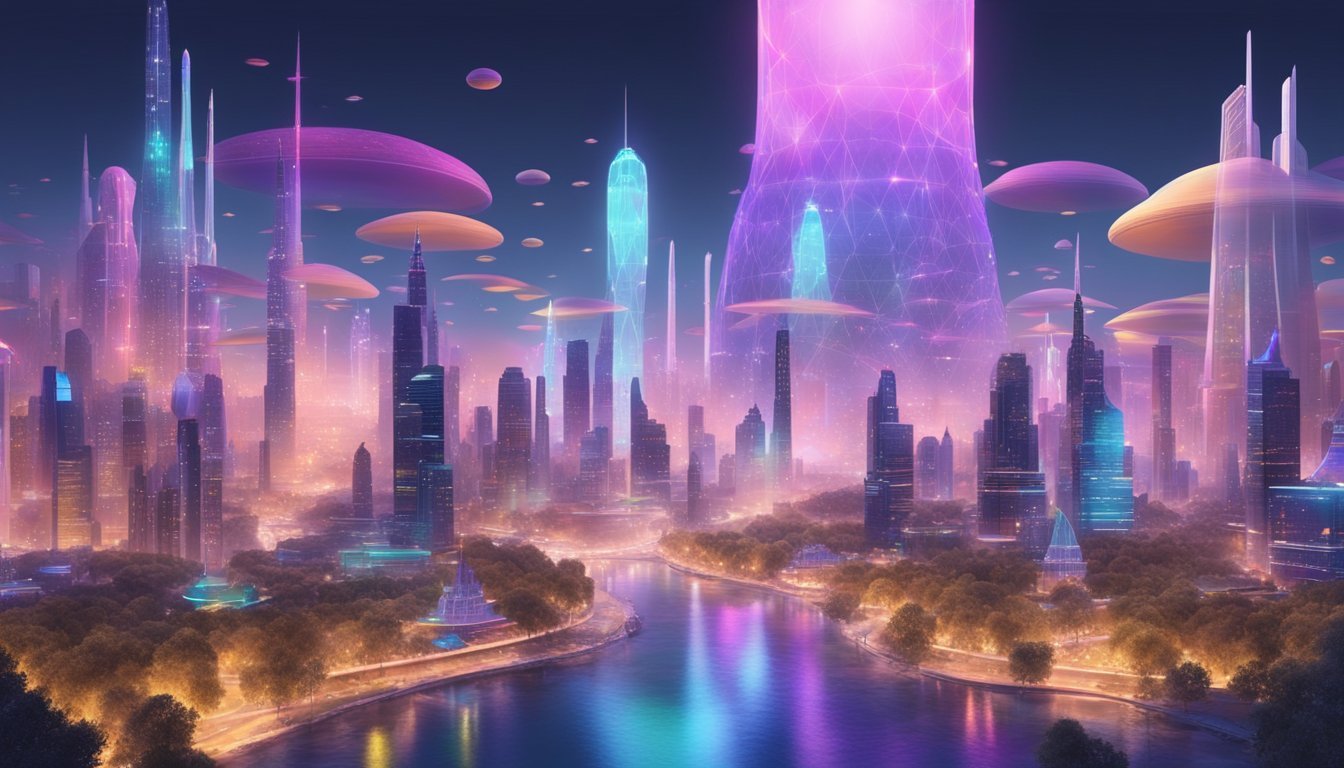AI: The Driving Force Behind the Metaverse's Evolution
The advent of artificial intelligence (AI) is transforming the digital realm, with the metaverse being one of its most ambitious frontiers. The metaverse, a collective virtual space created by the convergence of virtually enhanced physical and digital realities, relies heavily on AI to provide immersive experiences for its users. AI serves as the architect of these complex virtual environments, enabling them to be dynamically generated and responsive to user interactions. By simulating real-world physics and facilitating intelligent non-player character behavior, AI enhances the realism and depth of virtual worlds, making them more engaging for their inhabitants.
Integrating AI into the fabric of the metaverse unlocks a plethora of possibilities that extend well beyond simple task automation. It stands at the core of creating detailed and persuasive environments, which play a crucial role in shaping the types of experiences users can have. From customizing avatars to generating vast landscapes and intricate cityscapes, AI algorithms work tirelessly in the background to ensure that each virtual endeavor is as unique and personalized as possible. Moreover, AI-driven content creation tools empower users to contribute to the metaverse, fostering a collaborative and ever-evolving ecosystem.
The role of AI in the metaverse is not limited to world-building and content generation. It also helps in fostering social interactions and community building, providing a platform for rich, user-driven narratives to unfold. By analyzing user data and behavioral patterns, AI facilitates tailored experiences that resonate with individual preferences and enhance overall engagement. In this expansive digital universe, AI is the invisible hand that guides the orchestration of events, interactions, and environmental responses, paving the way for a more intuitive and enthralling metaverse experience.
Conceptualizing the Metaverse
Before diving into the intricacies of the Metaverse, it's essential to grasp its fundamental concepts and chart its progress from concept to reality.
Defining the Metaverse and Its Core Aspects
The Metaverse represents an expansive network of persistent, real-time rendered virtual worlds. These worlds offer a sense of immersive experience that blurs the lines between physical and digital realities. Key attributes of the Metaverse include interoperability, the continuity of data and identity, user-generated content, and a sustainable virtual economy.
Interoperability: Seamless movement of assets and information across different virtual environments.
Continuity: Persistent existence of user identity, history, and entitlements.
User-generated content: Users can create and trade digital assets.
Virtual economy: An economic system that underpins transactions within the Metaverse.
Historical Evolution and Key Milestones
The concept of a Metaverse took root with Neal Stephenson's 1992 science fiction novel 'Snow Crash', where he envisioned a digital space parallel to the physical world. Progressing through key milestones, the concept evolved with advancements in spatial computing, the internet, and meta platforms.
The 1990s: Origin of the idea and early virtual world simulations.
The 2000s: Increased internet bandwidth and the beginning of massively multiplayer online games (MMOGs), enhancing the communal virtual experience.
The 2010s: Rapid development in virtual reality (VR) and augmented reality (AR) technologies, setting the stage for contemporary Metaverse platforms.
2020s and Beyond: Tech giants invest heavily in developing the infrastructure and ecosystems necessary for a unified Metaverse.
The trajectory of the Metaverse has been shaped significantly by these technologies, with each milestone contributing to a more cohesive and immersive experience.
Foundations of AI in the Metaverse
The Metaverse is charting new territories in digital interaction, with Artificial Intelligence (AI) serving as the cornerstone for its immersive experiences. It is the blend of various AI technologies that transforms the Metaverse into a complex, responsive environment capable of supporting vast user interactions.
AI Technologies Powering the Metaverse
Within the tapestry of the Metaverse, a diverse array of AI technologies play distinct roles. They range from procedural content generation to interactive NPCs (Non-Player Characters), all aimed at forging an engaging virtual realm. These technologies act as the building blocks, determining not just what is possible in the Metaverse, but also setting the stage for future advancements.
Role of Machine Learning and Deep Learning
Machine learning and deep learning are at the heart of the AI that drives the Metaverse. They underpin various systems, from content personalization to behavior prediction. Algorithms learn user preferences and patterns to suggest relevant content, enhancing their journey within this digital universe. It's through these learning models that the Metaverse can evolve, reacting and adapting to its users over time.
Natural Language Processing for Enhanced Interactions
Natural Language Processing (NLP) facilitates seamless communication between users and the virtual environment, removing the barriers of complex interfaces. With NLP, users can issue voice commands, interact with virtual entities, or receive information—all in a conversational manner, making exchanges within the Metaverse feel as natural as those in the real world.
Computer Vision and Spatial Recognition
The integration of computer vision ensures that virtual spaces are not just seen, but understood by AI. This understanding allows for advanced features such as gesture recognition, object identification, and spatial awareness. Paired with spatial recognition, these technologies enable the Metaverse to become a space that responds contextually to user actions, enhancing the realism and depth of the virtual experience.
User Experience Design
In the realm of the metaverse, user experience design is pivotal for crafting spaces that are both engaging and responsive to individual needs. It leverages artificial intelligence to tailor user interactions and construct dynamic narratives within virtual environments.
Creating Personalized Avatars and Environments
The creation of personalized avatars and environments is at the heart of the metaverse experience. AI algorithms assist in offering a high level of customization, allowing users to model avatars that accurately reflect their physical characteristics or desired self-representation. Moreover, environment personalization is enhanced by AI, which can learn from user preferences and behaviors to adjust settings and aesthetics for each individual, resulting in a deeply personalized experience.
Examples of personalization through AI in the metaverse:
Adjusting avatar features such as skin tone, attire, and accessories
Suggesting environment themes based on user interaction history
Generative AI plays a crucial role in evolving the metaverse by enabling personalized virtual environments. This enhances user engagement by adapting spaces to personal tastes and interests.
Interactive Storytelling and Dynamic Virtual Worlds
AI is fundamental in crafting interactive storytelling within the metaverse. It creates dynamic virtual worlds that evolve based on user interaction, providing unique and contextual narratives for each visitor. AI-driven storytelling responds to the decisions and actions of the user, making every path through the story distinctive and engaging.
Key aspects of AI-driven interactive storytelling:
Non-linear plot progression dependent on user choices
Adaptive narratives that create a sense of agency and impact
Through the use of generative AI, interactive elements are seamlessly integrated into virtual worlds, making them not just backdrops, but active participants in storytelling. This results in rich, layered experiences where every narrative thread is an invitation to explore further.
The role of Generative AI in the metaverse is to establish new grounds for user engagement by providing stories and content that are not just consumed but interacted with, leading to a more immersive experience.
AI-Driven Content Creation and Curation
Artificial Intelligence (AI) has profoundly transformed the way content is created and curated in the Metaverse. By leveraging AI's capabilities, developers and creators can produce rich, dynamic, and interactive environments that were not possible before.
Generative AI and User-Generated Content
Generative AI stands at the forefront of user-driven creativity within the Metaverse. Tools such as DALL-E, an AI system capable of generating realistic images from textual descriptions, empower users to contribute original visual elements to their virtual worlds. This innovation facilitates content creation on an unprecedented scale, allowing for complex assets to be crafted with reduced manpower and increased efficiency.
For instance, NPCs (non-player characters) in gaming environments can be designed to have more life-like behaviors and appearances. Through algorithms and learning models, they can interact with users in more engaging and realistic ways, improving the overall user experience.
Automation in World Building and Creative Content Production
Generative AI is also instrumental in automating world-building tasks. It enables rapid content production, such as the generation of diverse sceneries, textures, and objects, enhancing the authenticity and appeal of digital terrains without extensive manual labor. By introducing AI into creative workflows, developers can escape the limitations of finite resources and invest more time into innovation and finer details of the virtual experience.
Benefits of automation in the Metaverse:
Faster content production timelines.
Reduction in the resources required for world building.
Enhanced ability for platforms to support user-generated content.
By combining these efforts, AI fosters a Metaverse that is not just a repository of prefabricated experiences but a canvas for collaborative creation and continuous evolution.
Expanding the Ecosystem
In the Metaverse, AI is the linchpin for cultivating an environment where entertainment, commerce, and education merge seamlessly, blurring the lines between virtual and physical realities to foster robust economies and marketplaces.
Incorporating Entertainment, Commerce, and Education
In the Metaverse, entertainment is transformed through AI-curated experiences, offering personalized virtual concerts, games, or exhibitions. Commerce unfolds in immersive storefronts where AI assists in personalized shopping experiences. Education benefits from interactive and engaging 3D learning environments that adapt to individual learning styles.
Entertainment: Tailored virtual events and on-demand content creation
Commerce: Intelligent virtual assistants and dynamic pricing algorithms
Education: Adaptive learning platforms and virtual classrooms
Integration of Virtual and Physical Realities
The fusion of mixed reality (MR) brings together the best of both worlds, enhancing the physical with the digital. AI bridges this gap by contextualizing virtual experiences in the real world, thereby expanding the Metaverse ecosystem.
Mixed Reality: Augmented Reality (AR) shopping experiences, Virtual Reality (VR) travel, and real-time language translation for seamless communication
Developing Economies and Marketplaces Within the Metaverse
The Metaverse economy thrives on AI-driven marketplaces, which facilitate the creation, valuation, and exchange of virtual goods and services. These marketplaces rely on cryptocurrencies and blockchain technology, ensuring secure and transparent transactions.
Economy: Virtual real estate trading, AI-generated content monetization
Marketplaces: Secure cryptocurrency transactions, decentralized finance (DeFi) services
Social Dynamics and Collaboration
The Metaverse is poised to revolutionize social interactions and collaborative efforts, propelled by Artificial Intelligence. From AI agents that enhance social engagement to the creator economy fostering teamwork, the integration of AI is central to the evolution of the Metaverse's social fabric.
Enhancing Social Interaction With AI Agents
AI agents, including virtual assistants and chatbots, are integral in creating sophisticated social dynamics within the Metaverse. They are programmed to understand and respond to human input, allowing for more engaging and personalized social interaction. For instance, AI can simulate crowd behaviors or serve as interactive NPCs (non-player characters), providing users with companions or opponents in various scenarios. Additionally, advanced AI like ChatGPT is being incorporated to offer conversational interfaces, enabling avatars to communicate with an unprecedented level of naturalness and context-awareness.
Collaborative Opportunities and Creator Economy
The Metaverse's collaboration spaces resemble digital sandboxes where creators can build and share experiences. Within these spaces, AI tools assist creators in developing intricate worlds by automating tasks, generating content, and offering data insights.
Creator economy thrives on collaboration, facilitated by AI-driven platforms that connect artists, developers, and entrepreneurs. Users benefit from AI that recommends partnerships or projects based on their skills and interests, enhancing collaboration. These tools not only streamline project management but also foster a network where users can co-create, share, and monetize their contributions, underpinning a vibrant creator economy.
Technical Infrastructure and Development
In the realm of the Metaverse, the underpinning technical infrastructure and its development are pivotal. They empower developers and designers to actualize immersive and intricate virtual spaces. This robust groundwork necessitates advanced tools, a fusion of software and hardware, and the simulation of realistic environments.
Tools and Frameworks for Developers and Designers
Developers and designers have at their disposal a diverse range of tools and frameworks that streamline the creation of Metaverse experiences. Nvidia's Omniverse platform, for instance, offers a collaborative environment tailor-made for real-time virtual world simulations, harnessing the power of AI to enhance the design process. Microsoft provides rich Mixed Reality Toolkits, which are instrumental for developers to concoct rich, interactive 3D content.
Seamless Integration of Software and Hardware
Seamless integration of software and hardware is essential to crafting an engaging Metaverse experience. Microsoft's Azure cloud services, in tandem with AI capabilities, deliver the necessary infrastructure to ensure that the computational heavy lifting scales across devices. This infrastructure facilitates real-time data processing and content delivery, essential for a smooth user experience that feels continuous across different platforms.
Advancing Realistic Landscapes and Physics
Creating realistic landscapes and implementing believable physics are critical for immersion. Developers employ advanced graphics engines enabled by AI, such as Unreal Engine and Unity, to render intricate details in vast, lifelike environments. Nvidia's physics simulation technologies are key to offering a natural feel to the objects and entities within the Metaverse, ensuring that virtual elements adhere to the laws similar to the physical world.
The Future of AI in the Metaverse
The Metaverse is on the brink of transformation through AI, with new applications emerging that extend far beyond gaming and social media, leveraging advanced predictive algorithms and generative models, all while navigating the complexities of ethical and privacy considerations.
Prospective Applications Beyond Gaming and Social Media
The Metaverse is set to revolutionize a multitude of sectors. Healthcare, for instance, could see AI enabling virtual surgeries or medical training environments. Education could dramatically evolve with AI creating deeply personalized learning experiences, adapting curriculum dynamically to a student's learning pace and style. In retail, AI may craft personalized shopping experiences with virtual try-ons and AI shop assistants. The workplace could transform with AI-facilitated simulations for training and virtual co-working spaces.
Evolving Trends: Predictive AI, GANs, and Beyond
Advances in Predictive AI are set to propel the Metaverse, offering tailored content curation and enhanced anticipation of user actions for more immersive experiences. Generative Adversarial Networks (GANs) push the envelope further by creating hyper-realistic avatars and environments, even generating new, unseen content. Such AI systems will be critical for dynamic world-building in the Metaverse, making each user's experience unique and vibrant. This level of personalization is powered by large volumes of user data, heightening the importance of robust data privacy measures.
Addressing Ethical and Privacy Concerns
Ethical concerns in AI use within the Metaverse revolve around data privacy and the handling of user data. It’s vital to establish stringent protocols that ensure privacy, prevent bias, and safeguard against misuse of AI-generated content. Companies must be transparent about AI's role in data collection and utilization, and users should have control over their personal data. Policymakers and technologists need to work together to set ethical boundaries, ensuring the Metaverse remains a safe and fair space for all users.
Challenges and Opportunities for Society
As the Metaverse expands, it presents both obstacles and potential for societal advancement, touching upon facets of security, inclusivity, and societal norms—each of which deserves focused consideration.
Safeguarding Security and Data in Virtual Environments
Security remains one of the paramount challenges as individuals and entities inhabit virtual spaces. Incidents of data breaches and identity theft could increase as the Metaverse becomes a repository of sensitive personal information. Initiatives like Artificial intelligence powered Metaverse are critical in enhancing safeguards against cyber threats, ensuring robust encryption, and deploying AI-driven security protocols to protect user data.
Ensuring Accessibility and Inclusivity
Accessibility and inclusivity are fundamental to the democratization of the Metaverse. There is an opportunity to design experiences that are universally accessible, catering to users with diverse abilities and from varied socioeconomic backgrounds. Overcoming language barriers, designing for differently-abled individuals, and creating affordable access points are vital steps that can make the Metaverse a welcoming environment for all.
Implications of the Metaverse on Global Society
The Metaverse's impact on society extends beyond digital interaction—it influences healthcare, finance, and cultural exchange. Healthcare can leverage 3D modeling for educational purposes and remote surgeries, as proposed by Forbes. Financial systems within the Metaverse could revolutionize how we approach currency, investments, and transactions, demanding transparent and accountable economic structures. As societies engage more within these parameters, the collective cultural experience will evolve, shaping global interaction and identity.



